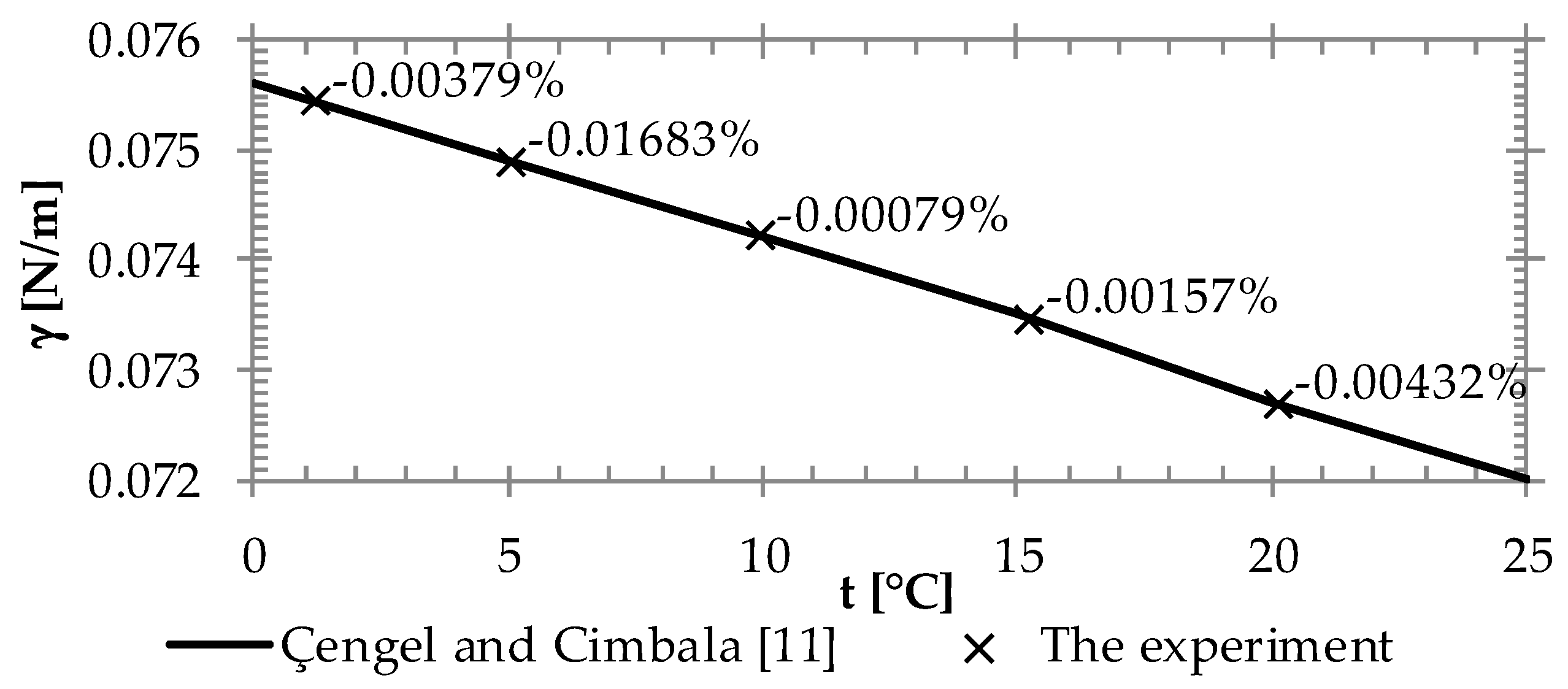The Latest Method for Surface Tension Determination: Experimental Validation †
Abstract
:1. Introduction
2. The Experiment
3. Determining Specific Gravity of the Fluids
4. Discussion
Author Contributions
Acknowledgments
Conflicts of Interest
References
- Gil, B.; Rogala, Z.; Dorosz, P. Pool Boiling Heat Transfer Coefficient of Low-Pressure Glow Plasma Treated Water at Atmospheric and Reduced Pressure. Energies 2020, 13, 69. [Google Scholar] [CrossRef]
- Zhang, X.; Li, T.; Ma, P.; Wang, B. Spray Combustion Characteristics and Soot Emission Reduction of Hydrous Ethanol Diesel Emulsion Fuel Using Color-Ratio Pyrometry. Energies 2017, 10, 2062. [Google Scholar] [CrossRef]
- Tziourtzioumis, D.N.; Stamatelos, A.M. Experimental Investigation of the Effect of Biodiesel Blends on a DI Diesel Engine’s Injection and Combustion. Energies 2017, 10, 970. [Google Scholar] [CrossRef]
- Hussain, S.M.S.; Kamal, M.S.; Murtaza, M. Synthesis of Novel Ethoxylated Quaternary Ammonium Gemini Surfactants for Enhanced Oil Recovery Application. Energies 2019, 12, 1731. [Google Scholar] [CrossRef]
- Park, J.; Lee, K.-H.; Park, S. Comprehensive Spray Characteristics of Water in Port Fuel Injection Injector. Energies 2020, 13, 396. [Google Scholar] [CrossRef]
- Hartland, S.; Hartley, R.W. Axisymmetric Fluid-Liquid Interfaces. Tables Giving the Shape of Sessile and Pendant Drops and External Menisci, with Examples of Their Use; Elsevier Scientific Publishing Company: Amsterdam, The Netherlands; Oxford, UK; New York, NY, USA, 1976. [Google Scholar]
- Hoorfar, M.; Neumann, A.W. Recent progress in Axisymmetric Drop Shape Analysis (ADSA). Adv. Colloid Interface Sci. 2006, 121, 25–49. [Google Scholar] [CrossRef] [PubMed]
- Gajewski. Liquid–gas interface under hydrostatic pressure. In WIT Transactions on Engineering Sciences; WIT Press: Split, Croatia, 2012; pp. 251–261. [Google Scholar]
- Gajewski, A. The Surface Tension Effects in Rivulets and Drops; Oficyna Wydawnicza Politechniki Białostockiej: Białystok, Poland, 2016. (In Polish) [Google Scholar]
- Gajewski. A couple of new ways of surface tension determination. Int. J. Heat Mass Transf. 2017, 115 Pt B, 909–917. [Google Scholar]
- Çengel, Y.A.; Cimbala, J.M. Fluid Mechanics Fundamental and Applications, 3rd ed.; McGraw-Hill Education: Singapore, 2014. [Google Scholar]

Publisher’s Note: MDPI stays neutral with regard to jurisdictional claims in published maps and institutional affiliations. |
© 2020 by the authors. Licensee MDPI, Basel, Switzerland. This article is an open access article distributed under the terms and conditions of the Creative Commons Attribution (CC BY) license (https://creativecommons.org/licenses/by/4.0/).
Share and Cite
Teleszewski, T.J.; Gajewski, A. The Latest Method for Surface Tension Determination: Experimental Validation. Proceedings 2020, 51, 3. https://doi.org/10.3390/proceedings2020051003
Teleszewski TJ, Gajewski A. The Latest Method for Surface Tension Determination: Experimental Validation. Proceedings. 2020; 51(1):3. https://doi.org/10.3390/proceedings2020051003
Chicago/Turabian StyleTeleszewski, Tomasz Janusz, and Andrzej Gajewski. 2020. "The Latest Method for Surface Tension Determination: Experimental Validation" Proceedings 51, no. 1: 3. https://doi.org/10.3390/proceedings2020051003
APA StyleTeleszewski, T. J., & Gajewski, A. (2020). The Latest Method for Surface Tension Determination: Experimental Validation. Proceedings, 51(1), 3. https://doi.org/10.3390/proceedings2020051003




